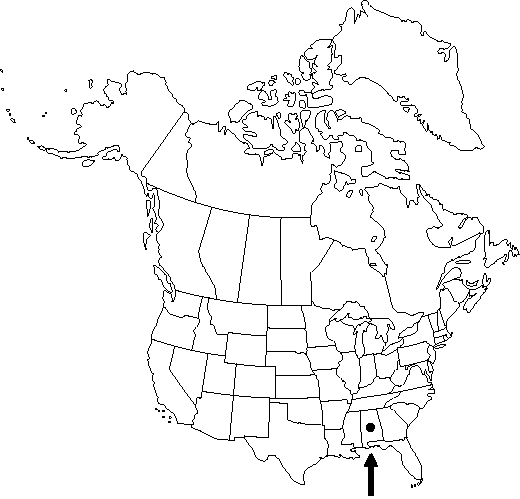Hexastylis speciosa
Torreya 24: 79-80. 1924.
Conservation concernEndemic
Synonyms: Asarum speciosum (R. M. Harper) Barringer
Treatment appears in FNA Volume 3.
Rhizomes: internodes short, leaves crowded at rhizome apex. Leaf-blade variegate or not, triangular to broadly triangular, subhastate. Flowers: calyx-tube abruptly contracted near middle, proximally narrowly cupshaped, distally broadly cylindric, 10-20 × 10-20 mm, inner surface with well-developed reticulations, lobes spreading, 4-8 × 6-8 mm, adaxially puberulent; stamen connective extending slightly beyond pollen-sacs; ovary ca. 1/3-inferior; ovules ca. 6 per locule; style 2-cleft to stigma. 2n = 26.
Phenology: Flowering spring (April-May).
Habitat: Shaded sites, well-drained sandy loam in open pine-deciduous forests above acidic streams or bogs
Elevation: 70 m
Discussion
Of conservation concern.
Hexastylis speciosa is endemic to a small area north of Montgomery, Alabama.
Selected References
None.
Lower Taxa
None.
"broad" is not a number."connate" is not a number.
... more about "Hexastylis speciosa"
extrorse +
absent +
fleshy +
triangular +
contracted +
cylindric;cup-shaped +
tubular +
enlarged +
irregular +
fleshy +
absent +
reduced +
fan--shaped +
Ala. +
copious +
bisexual +
petiolate +
absent +
absent +
triangular +
Shaded sites, well-drained sandy loam in open pine-deciduous forests above acidic streams or bogs +
glabrous +
glabrous +
subhastate;triangular;broadly triangular +
leathery;membranous +
crowded +
valvate +
spreading +
puberulent +
broad +
anatropous +
absent +
vestigial +
4-6-carpellate +
Torreya +
1924 +
well-developed +
not winged +
ovoid +
network +
weak;strong +
glabrous +
distinct +
aerial +
absent +
2-cleft +
distinct +
differentiated +
Hexastylis speciosa +
Hexastylis +
species +
rudimentary +
differentiated +
rhizomatous +
aromatic +
